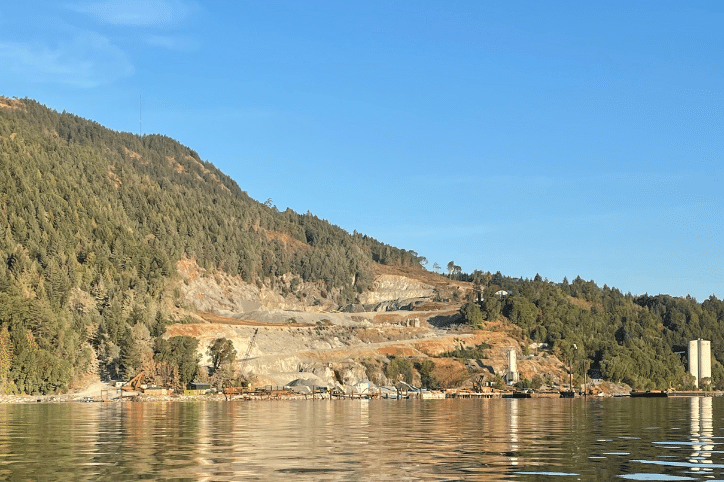I am disappointed by Minister George Heyman’s (Environment and Climate Change Strategy) decision to decline an environmental assessment for the expansion of the Bamberton Projects quarry in the Saanich Inlet.
Minister Heyman failed the environment by not following the precautionary principle as was advised in an exhaustive study of the Saanich Inlet. His handling of the inherent and treaty rights of the Tsartlip and Tsawout First Nations is deeply concerning, and the enhanced mines permitting process, and cumulative effects analysis, are unknown and unregulated processes.
Minister Heyman’s primary responsibility is to the environment. In 1996, his Ministry published The Saanich Inlet Study. Through nearly 500 pages, the Province of British Columbia described in comprehensive detail their scientific and social analysis of the inlet. They make dozens of recommendations including that “the Precautionary Principle must apply where there is uncertainty or missing information” (s. 12, p. 13).
Minister Heyman ignored the report, convinced by the Environmental Assessment Office’s (EAO) determination that the potential negative impacts of the project, will not be greater than can be mitigated, or that the “permit conditions” and “required best management practices” can’t handle. (Reasons for Decision, 2023. p. 4).
He is confident the province can “consider and mitigate potential impacts” of Indigenous rights after-the-fact, essentially admitting his government is ignoring their commitments to Indigenous people (Reasons for Decision, 2023. p. 5). Make no mistake, Minister Heyman is sidestepping “free, prior, and informed consent” and numerous other articles of the law, he and his colleagues celebrate (Declaration Act, 2019). In June 1995, the Ministry of Environment published the First Nations consultation from The Saanich Inlet Study (1996). Those recommendations have also been ignored or minimized in Minister Heyman’s decision (p. 50)
Minister Heyman has made it clear this project is free to be approved by the mines minister, and that every potential environmental and Indigenous rights issue that may arise will not be an obstacle to the expansion proceeding, but they will be mitigated. However, he also recognizes the potential environmental, social, and legal impacts of his decision, so he proactively contacts a couple of his colleagues – Josie Osborne, Minister of Energy, Mines, and Low Carbon Innovation, and Nathan Cullen, Minister of Water, Land, and Resource Stewardship.
The outcome of those meetings has Minister Heyman making up two new processes on the fly. Despite its shortcomings, the environmental assessment is a legal process, it is regulated, and participants can be certain of consistency of the program from application to application. An enhanced Mines Act permit process as is described by Minister Heyman is still to be designed, and unregulated. This works for the Minister and his colleagues because he is creating a bureaucratic environment free of proper oversight and accountability (Reasons for Decision, 2023. p. 4).
Re-ordering the timing of all the analysis and permit considerations is a critical component in Minister Heyman’s decision to decline the environmental assessment. It was a major roadblock for the mines minister whose job it is to assess and approve new and/or expanded mines. If an assessment was ordered, then the mine permit process would have had to wait until the environmental assessment was completed before it could proceed. By reordering the process, from one stream to two streams, Minister Heyman has cleared the road of all the legal and regulatory debris for mines to proceed with assessing the new mine expansion application. By getting the Resource Stewardship Ministry to create a cumulative effects analysis, Minister Heyman inserts more unknowns into the process. Also, what he is proposing is an analysis, nothing more. The enhanced mine permit process and cumulative effects analysis are half-measures.
It is important to note that the Ministry of Mines already has a mine permitting process. They are currently responsible for consulting and engaging the public, and for upholding the provincial governments obligations to Indigenous people, respecting treaties, and understanding the impact of the project on the environment. The problem is that the Mines Ministry has already let the Saanich Inlet down. The process has failed First Nations and neighbouring communities, and there is no certainty that an enhanced process will achieve anything more.
Minister Heyman has relieved the provincial government from doing anything different than what is required in the laws and regulations currently on the books. Everything else, including the enhanced mine permit process and cumulative effects analysis, will simply inform, recommend, and suggest, not require.
He failed the environment by not heeding the important advice from The Saanich Inlet Study to apply the precautionary principle along with numerous other recommendations his Ministry has systemically ignored in the ensuing decades.
Minister Heyman offended the inherent and treaty rights of the Tsartlip and Tsawout, as they cannot be simply dispensed and ignored as he has done. Additionally, the Minister should not be able to manufacture new processes that have no accountability, out of thin air.
Instead of ordering a fair and robust process, Minister Heyman has handed the file back to the mines minister and the resource stewardship minister with a few notes. At the same time, he has all but assured us that those neighbouring communities will be churning through these unknown processes for an unknown amount of time, to an unknown end point. Thanks Minister.


0 Comments